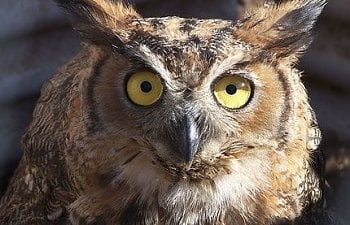General Information
Owls are a group of predatory birds that belong in the order Strigiformes. Most owls are solitary and mostly nocturnal, with some exceptions, such as the Northern Hawk Owl. Owls have acute visual and hearing senses. Their eyes have a large retina that can create a spatial image even in darkness. Owls have asymmetrical ear placements which give them special hearing abilities for easier tracking of prey and they have the ability to swivel their heads over 270 degrees.
They are characterized by their small beaks, large eyes, and wide faces. There are between 220 and 225 extend species, divided into two families: the typical owls and the barn owls.
Range
Owls are found in all regions of the Earth, except Antarctica, most of Greenland, and some remote islands. They prefer to hunt over open habitats and are typically found near places where sufficient prey, primarily rodents, and small mammals, thrive. Areas with open structures such as old or abandoned barns, sheds, and similar buildings are ideal nesting sites for barn owls, though they also make use of natural tree cavities or dense trees and brush. They may be attracted to barn owl nest boxes where natural nesting sites are unavailable.
Barn owls are found on every continent except Antarctica. The Arctic tundra of the northernmost parts of Alaska, Canada, and Eurasia is home to Snowy owls, who are attracted to open areas like coastal dunes and prairies. They have been reported as far south as the states of Texas, Georgia, and the American Gulf states.
Methods of Kill
This bird of prey employs similar hunting skills as hawks. Perched on a vantage point, such as a tree branch or fence post, they keep an eye out for possible prey and when the opportunity to hunt presents itself, they will swoop in silently and grab their unsuspecting prey with their sharp talons. Studies found them to be among the quietest birds when in flight, due to their serrated wing feathers. This keeps turbulence to a minimum and makes flight practically silent.
If you see dead birds in your area with surgical-looking cuts on their necks, you can be sure this was an owl’s doing. With a sharp beak and talons like those of hawks, falcons, and eagles, this predator can snap its prey dead with its beak right before swallowing the prey whole. It then regurgitates the indigestible parts like fur, feathers, scales, and bones. Owls have been known to snap chicken necks like scissors and feed on them. Unlike full-grown hens, chicks are excellent prey because they can easily cart them away with their talons.
Contrary to popular belief owls will also hunt during the day.
Prevention & Treatment
Owls are intelligent birds and they learn easily from observing your poultry farm. Things like keeping night lights on at night can be a short-term deterrent. But if they can get away with a few chicks as spoils, they will do so every day up until you are able to secure the chicken coop. It’s a good idea to spread out a bird net over your chicken run or yard to stop them swooping in on your flock. If the nets are made of meshed fishing lines, the owl won’t be able to see or get through when they swoop down with their outreached wings. You can also put in an electrical mesh fence. Others put visual deterrents like wind chimes, CDs, ribbons, or even strobe lights. You can also try motion-activated sprinklers. Blow-up owl dolls have also been a reported success.
Just be sure not to kill them. In the United States hawks and owls are protected under the law, specifically the Migratory Bird Treaty Act (16 USC, 703-711). If you are reported, you risk paying a steep fine and can even spend a few months in jail.

